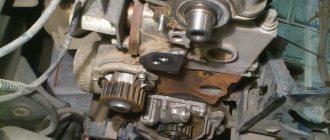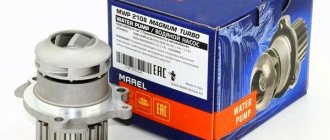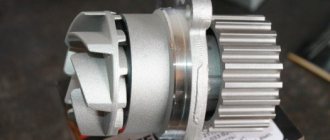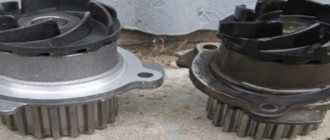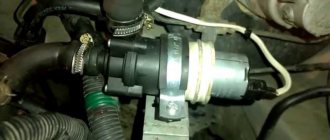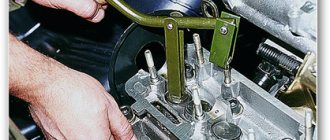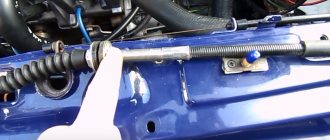The cooling system integrated into the power unit of the popular domestic bestseller Lada Granta, which has 8 valves, has a traditional design. Among the most important components of this unit is a pump. Modifications of the engines offered in terms of equipment for the Granta are endowed with the following factory designations:
- "VAZ-11183";
- "VAZ-11186";
- “VAZ-21126” (similar for automatic transmission);
- "VAZ-21127".
The pump must be replaced correctly; its selection should be made based on catalog data. Correct selection of parts is a very important aspect of engine safety, since the “safety” of the timing belt depends on the pump (its functionality). Well, which pump to choose is ultimately up to you.
Next, we will clarify the catalog code of the component in question. It looks like this: 21114-1307010-00 or 21114-1307010-01.
You can check the amount of wear of the product and the need for its replacement by manual manipulation. To do this, you can limit yourself to visual observation. If such a measure does not bring the desired result, then the element must be dismantled in order to finally verify the presence of breakage or wear. In this case, the pump needs to be replaced.
Next, let’s look at the signs the presence of which “classifies” an element as not being used:
- noise generated by a worn bearing;
- traces of smudges indicating damage to the seal;
- if wear or breakage of the impeller is detected, then this fact will be confirmed by insufficient fluid circulation in the cooling circuit (temperature increase);
- the appearance of axial play on the shaft can also reliably indicate the “death” of the bearing.
All this indicates that the pump needs to be replaced.
Characteristics of the device, symptoms of failure
This is what the pump for Kalina looks like
The pump works together with the engine. It ensures uninterrupted operation of the fuel supply and cooling systems. The first carries out the transfer of fuel from the tank to the engine, the second - forced pumping of antifreeze or antifreeze.
The water pump-impeller, located on the shaft, is covered by a housing. The shaft has ball bearings at both ends and rotates due to torque by means of a belt attached to the engine.
Symptoms of a broken water pump:
- the red section of the tachometer indicates the overheating temperature of the car engine, this is confirmed by the readings of the device;
- in the cabin of the Kalina car there is a persistent smell from the evaporation of antifreeze;
- a sound similar to a whistle is heard quite clearly - repair or replacement of the pump is necessary;
- Drops of liquid may be found under the car (to identify the problem, leave a sheet of white paper under the car overnight).
To restore the functioning of the pump, experience and special tools are required. It is advisable to entrust the work to specialists at a service station, and replace the pump with a new one.
How exactly to dismantle the old pump
The installation procedure for a new coolant pump is not particularly difficult from a technical standpoint. However, the performer is required to be meticulous and responsible in execution. It is also recommended to replace the timing belt, as well as its special rollers (tensioner and bypass).
By the way, the process of replacing the pump on a VAZ 2112 will take you no more than a few hours. In fact, you will gain irreplaceable practical skills and save more than 1 thousand rubles that you would be asked to pay at a service station. The benefits are more than obvious.
1. We get rid of the absorber and power steering reservoir, since they will interfere with us in further repair work; 2. Remove the service belt by loosening the tension roller of the latter; 3. Disconnect the tension roller, remove the protective cover under it; 4. Next, for the convenience of performing the work, we will have to remove the right wheel and mudguard; 5. Before the next step, do not forget to drain the antifreeze into a clean container; 6. Rotating the crankshaft, through a belt drive, turn the camshaft so that the small protruding mark on it coincides with a similar one on the protective cover body; 7. Ask a friend to engage fifth gear, pressing the brake all the way. Thus, we lock the crankshaft, remove the pulley and the protective cover under it; 8. We loosen the tension of the timing belt by releasing the tension and idler rollers. Now you can remove the belt itself; 9. Unscrew the rollers, camshaft pulleys and the plate under them
Note that the right camshaft is an original design; 10. Finally, we got to the pump
Unscrew the three hex bolts holding it. The pump can be seated so tightly and hermetically that it can only be removed with a hammer and a wooden handle.
Congratulations, the replacement pump for VAZ 2110-2112 is ready. We perform assembly in reverse order.
Fuel pump: design features
Carburetor cars had mechanical pumps. The drive or dam pushed the diaphragm, in the process a vacuum was created and fuel entered the carburetor. Nowadays, almost all cars have an injection engine and an electric pump. It delivers hot food at high speed and maintains stable pressure in the system. The electric motor, together with the working rotor, pushes the fuel. The pump is located in the gasoline tank itself. During operation, fuel becomes coolant and lubricant. There are car models that have two pumps: the main one is under the hood, the worker is located in the fuel tank.
- ODS is the main way to protect a machine. This is a closed-type forced circulation liquid. If the interior heating device supplies cold air, but the Kalina engine overheats, it means that there is a malfunction in the operation of the car. Components of the system:
- special motor shell;
- heat exchanger with electric fan;
- device for maintaining a constant temperature;
- suction device;
- expansion tank;
- contact tubes.
By looking into the plastic expansion tank, you can visually check the amount of antifreeze and antifreeze. There are special marks for high and low levels of liquids in the tank. Outside the tank, there is a pipe at the top for connecting to the heat exchanger sleeve, at the bottom - to the filling tube.
- Expansion cap with breathers. The device includes inlet and outlet breathers. They are capable of providing systemic impermeability. The intake valve maintains elevated pressure in the hot engine. As the temperature rises, steam leakage decreases. The reduced pressure promotes the opening of the released breather as the car engine gradually cools.
- The pump pumping antifreeze is a blade of rapid discharge. The crankshaft wheel drives the pump through a toothed belt on the timing rod. Its body consists of aluminum. The shaft rotates in a double-row ball bearing, which contains enough fuel oil for the entire warranty period. The outer ring is tightened with a self-tapping screw. The gear is pressed in at the front, the impeller, retaining ring, and oil seal are at the rear. Antifreeze or antifreeze leakage is monitored through a hole in the pump shell. This method will help identify unit malfunctions. If the pump cannot be repaired, it is replaced with an identical assembly device. The coolant corrects the redistribution of antifreeze. System cooling of paired cycles occurs as follows:
- in a larger circulation circle, antifreeze penetrates through the engine shell to the radiator battery;
- when moving in a small circle, antifreeze or antifreeze passes only through the cooling shell, without getting into the heat sink.
- Thermostat. The thermal unit and two breathers are components. There is a redistribution of the flow of antifreeze or antifreeze. When the engine is cold, the node valve redistributes the direction of fluid movement. It begins to circulate over a smaller radius, without entering the radiator. High temperatures of 85°C allow the valves to open and allow fluid to flow into the radiator. At temperatures above 100° C, the main valve is fully open, the spare valve closes. Liquid circulation occurs over a large radius.
- Antifreeze or antifreeze temperature meter. This device is screwed into the cylinder head for automatic control of coolant. The sensor is connected to the temperature indicator on the instrument panel of the car. This information is sent to the controller.
- Heating heat sink. Built into the engine cooling system, it heats the vehicle interior by circulating hot coolant.
- The radiator consists of 2 plastic tanks in a vertical position. One of them has a partition. There are 2 more rows of rounded aluminum tubes, aligned horizontally, that pass through the cooling plates. The pipes are connected to the tanks through a rubber key. Antifreeze enters through the upper pipe and exits through the lower pipe. The inlet pipe is located next to a thin steam exhaust hose. The radiator has a casing with an electric motor. Drain plug at the bottom.
- The fan maintains the temperature inside the car. As soon as the controller receives the signal, the fan is turned on via a relay.
The cooling system consists of a radiator battery and a throttle heating unit. The circulation of antifreeze or antifreeze here occurs continuously, regardless of the location of the coolant valve.
Symptoms of a damaged water pump
- Motor overheating - the pump is faulty, the drive belt is not working, the impeller is damaged.
- The temperature arrow indicator is located closer to the middle. You need to stop to check the radiator. In case of inoperability, the unit and pump drive will heat up.
- Noisy, smell of antifreeze in the cabin.
- Low circulation of antifreeze is the result of pump destruction. Diagnosis is carried out with the engine idling; at the same time, you need to clamp and lower the outer radiator hose. During normal operation of the pump, a push of antifreeze in the hose will be felt.
- Large play in the ball bearing of the pump - damage to the ball bearings.
It is necessary to change the water pump if the car's mileage is 90 thousand km.
Fault diagnosis
If the first suspicions are confirmed, it’s time to make, so to speak, an expert opinion confirming the need to repair the VAZ 2110 pump, for which you should carry out several simple steps described below.
Checking the timing belt
First, let's check the pressure of the cooling system when the engine is warmed up to operating temperature. Let's try to press the rubber hose with our fingers. If the fluid pressure does not provide us with noticeable resistance, the pump is faulty.
Check the timing belt tension using the appropriate inspection window. Repair of the VAZ 2110 pump will indicate a worn or bitten belt, weakened by its tension, or it will be completely soaked in antifreeze.
In any case, after 20-30 thousand km. mileage, you should carefully listen to the characteristic humming or knocking sounds of a stuck pump system bearing. After 50 thousand, it is worth thinking about the mandatory need to replace the timing belt, pump and tension pulley.
Replacing antifreeze or antifreeze
Coolant reservoir
To perform fluid replacement work, you need to have special tools on hand to remove nuts and bolts. The Kalina car must be installed on a horizontal, level surface. If this is not possible, you should try to position the car so that its front parts are clearly visible. Work is performed in a certain sequence.
- Remove the engine splash guard.
- Reset the negative terminal of the battery.
- Unscrew the plug from the expansion tank.
- Remove the drain plug located on the cylinder block. Place a container under the drain.
- Remove the ignition module along with the holder, because it interferes with access to the drain.
- Remove the drain plug from the radiator battery and wait for the coolant to drain.
- Tighten the drain plugs of the radiator and cylinder block.
- Remove the hose from the throttle heating fitting to drain the fluid by loosening the clamps.
- Pour antifreeze or antifreeze into the conservator until liquid flows from the removed hose. Now you can put the hose in place. After this, continue to fill the system with antifreeze or antifreeze. The liquid should fill the expander so that its level is a maximum of 3 cm below the specified level. Tighten the expander lock.
You need to start the engine and warm it up until the electric fan is in normal operating condition. After turning off the car engine, add coolant to the top line.
How to replace the water pump (pump) in a VAZ 2112
If the VAZ 2112 starts to lose coolant, then you first need to make sure that the expansion tank, clamps and hoses are intact; if there are no problems with these elements, then it may be that the water pump has failed. If you do a quick inspection, this is determined by the fact that the timing case cover is damp.
To do this, you need to unclip the timing belt inspection hatch and check the pump. It's not very easy to remove, so it will be a lot of work.
On a VAZ 2106 car, such repairs will be done quite simply and quickly. But in the VAZ 2112 (the pump) is located much deeper, so it will be more difficult to remove. At a minimum, you first need to disassemble the timing drive. First you will need to loosen the wheel nuts of the left front wheel, jack up the car and remove the wheel.
Next you need to unscrew the self-tapping screw securing the mudguard so that you can get to the crankshaft pulley. The generator mount is loosened to the bar, a thin long bolt is turned out with a belt tensioner. Next, you need to pull the belt so that the generator rests completely on the engine. The pulley mount must be removed.
The difficulty is that the bolt and crankshaft turn together, so you will need an assistant to press the brake pedal.
To unscrew the bolt, you need to take keys 17. The crankshaft pulley must be carefully removed and immediately released from the generator belt. You need to place a support under the pallet. The jack is lowered little by little. The support resting on the pallet is located under the engine and the power unit is raised. But it’s better not to remove the jack - it should be left as insurance.
The next step is to remove the front timing case cover, then the timing drive needs to be completely disassembled, remove the rollers, belt and rear timing cover. The drive is completely disassembled. Usually the internal cavity is covered with a damp black mass from a worn out belt and coolant. The belt loses its tension, so it wears out quickly.
But why does this happen? The water pump shaft is warped due to bearing wear. The belt loses tension and slides off the toothed pulley. The rollers hold the belt in place for some time, so it does not completely fly off. Subsequently, the belt wears out.
If repairs are not done in time, the belt will definitely come off the pulleys, then the pistons and valves will collide, and you will have to remove the cylinder head - and such repairs are quite expensive. At best, bent valves will need to be replaced.
If it is clear that there are problems with the water pump, then the engine should be turned off immediately and the car should be taken to a car service center.
Recommendations for choosing a pump
When the time comes to replace the pump on Kalina, car enthusiasts do not know which pump to buy so as not to throw money away. When purchasing, you need to refer to car catalogs and read reviews from other car owners about the quality of the pumps they have chosen. The magazine "Behind the Wheel" provides truthful information about spare parts for the Lada Kalina. You can get acquainted with tests and inspection results, opinions about manufacturing companies.
When purchasing, pay attention to the packaging. It must be of high quality, with a warranty card and an indication of the date of manufacture. Seals and gaskets to protect against damage must also be present. All products have holographic stickers. They must be glued neatly, without scuffs. The attached instructions should contain general information about the spare part and briefly describe how to install a particular unit.
A defective item will last approximately 10 thousand km. If there are no problems with the pump after covering 100 thousand km, we can say that the quality of the purchased product is excellent. The manufacturer installs a TZA pump on the Lada Kalina; it has a long service life.
The pump in the engine of any car is the main component of the cooling system. During operation, the motor gets quite hot. To avoid overheating, the unit is cooled with liquid (antifreeze), which is forced to circulate through a closed cooling system. It is the pump that ensures the circulation of coolant.
Purpose and recommendations
The pump serves to ensure correct and sufficient circulation of fluid in the engine cooling circuit of the Lada Granta, which has 8 valves. The element requires periodic attention, which will allow the system to operate for a long time without sudden and unpleasant surprises. Neglecting the control action may lead to a sudden breakdown, and this will inevitably lead to overheating of the motor.
A high-quality product has a positive effect on the performance of the heating system of the Lada Granta version of 8 valves. The presence of counterfeits is very common, so you should be on the safe side in advance and discuss with the seller the details of returning substandard goods.
Which pump to choose? For the Lada Granta model, we recommend choosing an 8-valve pump between two manufacturers that have earned trust among car owners, namely:
- "TZA" (Tolyatti Plant of Units);
- "LUZAR" (Lugansk Automobile Radiator Plant).
An important aspect of the choice is to focus on the color scheme present on the cases of the original products. It would also be useful to compare the grooves and stiffeners made on the impeller. We recommend that you carefully check the entire list of markings and inscriptions with those on the original products.
Today, the market space is able to offer an impressive range of these products for the Lada Granta, which has 8 valves. A guaranteed option to avoid a collision with a fake is to take the original pump with you. Lack of experience in “communication” with spare parts of this kind can play a cruel joke on the buyer.
Which pump should you choose? You can purchase a pump from an official dealer, and if this option is not available, below we provide guidelines for the following analogues with a price parameter:
- "TZA" (code 21116-1307010-00) at a price of 815-1100 rubles;
- “LUZAR” (number 21116-1307010-00), around 1240 rubles;
- “Kraft” with a price of about 1550 rubles;
- “HEPU”, the most expensive version (1800 rubles).
There is an opinion that you can find an “original” on the market at a dubious price, from 500 rubles. However, it is not possible to guarantee the authenticity of the product, so here only the buyer is responsible for weighing this step.
Lada Granta ground clearance
Granta cabin filter replacement
Lada Granta diagnostic connector where is it located
Functions and purpose of a pump in a car
Normal engine operation is impossible without a cooling system that circulates coolant through the pipeline (system components, pipes and hoses). The purpose of the pump (water pump) is to ensure constant movement of antifreeze throughout the entire system while the engine is running. If at some point the pump stops functioning, this will immediately disrupt the thermal conditions of the engine. In this case, the coolant will boil, which can lead to serious engine damage.
Structurally, the pump is a fairly simple structure, consisting of a metal body and a pulley and impeller located on the shaft. The pulley is driven by a belt from the engine crankshaft. An impeller is located on a shaft inside the housing, which moves the coolant with blades from one part of the cooling system to another. This is how the motor is cooled.
Signs and causes of failure
You can identify a broken part by the following signs:
- insufficient circulation of coolant and, as a result, frequent overheating of the engine;
- hum of bearings at the pump mounting location;
- presence of smudges at the pump mounting location.
These markers indicate the most likely causes of malfunctions in the Grants pump:
- bearing wear or damage;
- damage to the seal;
- worn sealing gasket;
- broken pump impeller.
In most cases, the part becomes unsuitable for major repairs and requires a complete replacement. Ignoring pump problems leads to replacing the timing belt and replacing components of the connecting rod and piston group. Valves and bearings may also need to be replaced.
Price issue
Replacing the pump on a Grant will not significantly impact the car owner’s budget. The cost of a new part is in the range of 1000-2000 rubles. For a thousand you can order a “native” pump produced by AvtoVAZ. Closer to the upper price threshold are expensive foreign-made analogues with an increased resource. The average service life of a new pump is 150,000-170,000 kilometers.
How to determine if the pump is faulty on Kalina
Despite its simple design, the pump may fail sooner or later. The first signal of incorrect operation of the water pump is extraneous noise that occurs when the engine is running. On the Lada-Kalina, the service life of the device is 60 thousand kilometers or after 48 months of operation. When one of these indicators is reached, it is recommended to replace the part without waiting for signs of malfunction to appear.
A fairly common reason for pump failure is the appearance of extraneous noise, which is associated with bearing wear.
But there are situations when a pump breakdown occurs much earlier than the specified period. Assessing the performance of a node is quite simple. To do this you need:
- Start and warm up the engine to operating temperature.
- Put a glove on your hand and squeeze the upper radiator pipe. When the pump is working, pressure will immediately be felt, which is due to the circulation of liquid through the system.
- If there appears to be little or no pressure, the pump should be inspected in more detail.
To assess the external condition of the pump, you will need to dismantle the timing drive casing and make sure it is in good condition. In this case, you should keep in mind the following nuances:
- If a coolant leak is observed at the junction of the device housing and the engine, it means that the oil seal has failed.
- The appearance of noise from under the hood when the engine is running indicates high bearing wear.
- There should be no axial movement when rocking the drive gear. If there is play, then normal operation of the pump is impossible.
A fairly common failure is the appearance of a coolant leak due to a damaged oil seal.
In these simple ways, the performance of the pump is determined. Even if you have no experience in car repair, you can find a faulty part. If it has been discovered that the pump has some problems, then there is no need to delay repairs, since simple malfunctions can lead to a major overhaul of the motor.
How to lubricate the pump on Kalina
If we talk about servicing a water pump, then we are talking about lubricating the bearings of the device. The design uses two bearings located on the shaft. They don't require much lubrication to function properly, but they are necessary. When working “dry”, the wear of the part increases sharply. With some experience, the pump can be lubricated without removing it from the car. All you need to do is follow these steps:
- Remove the timing cover.
- Remove dirt from the pump and its seating area.
- Apply a little Litol-24 lubricant to the housing joints.
Depending on the installed water pump, the product may have a lubrication hole.
High-quality lubrication can be performed during repair work, when parts that have failed are replaced. But if you lubricate the part in the manner described, you can also provide the bearings with the necessary amount of lubricant.
Instructions for changing the pump on Grant
Even before starting work, the car owner is recommended to read the machine’s operating manual; this will help you study the structure and location of the water pump in more detail. Remember - incorrect reassembly will lead to damage to the antifreeze in the system.
Then you need to prepare a place to work; normally this should be a dry box with a flat floor. Take care of good lighting, this will not only make the process easier, but will also insure you against the loss of small fasteners and small parts.
At the very beginning of work, the car is de-energized by removing the terminals from the battery. In addition, the car is securely secured using parking shoes or a hand brake. All these manipulations are carried out to ensure maximum safety and convenience of the work process.
When replacing, it is extremely important not to deviate from the sequence of actions given below, since violation of the described order of work can cause a breakdown of the cooling system and lead to a fire in the car.
Replacing the pump itself will require you to do the following:
- First you need to completely drain the coolant;
- Next, unscrew the fastening elements and dismantle the front cover of the timing case;
- Then fix the piston of the first cylinder at top dead center;
- The car is put into gear;
- A jack is used to lift the front wheel of a car;
- The wheel rotates until the mark on the pulley coincides with the mark located on the rear timing housing cover;
- Work is being done to dismantle the timing belt, the tensioner pulley is dismantled;
- The rear cover of the timing case is removed;
- The fastening elements securing the water pump are unscrewed;
- The element is carefully pryed off with a screwdriver, after which it is removed;
- In the future, you should install a new pump and previously dismantled elements and assemblies, performing actions similar to dismantling, but in the opposite order.
- Before installing a new pump, the mating surface of the cylinder block is cleaned of the remnants of the previous gasket and a new one is installed in its place, having first applied a thin layer of waterproof sealant to it. The drainage hole on the water pump body should be directed downwards after installation;
- The last stage of the work process involves pouring coolant into the cooling system.
- The liquid is filled to a level 25-30 mm below the maximum mark on the tank, this is approximately 8 liters of antifreeze. The work is done.
Additional pump for Lada-Kalina
Some “Kalinovodov” are not satisfied with the standard heating of the cabin in winter. In order to somehow correct the situation and ensure the flow of hot air at idle, they resort to installing an additional pump. The part also provides better cooling in hot weather, especially when idling in traffic jams.
An additional pump avoids the formation of air in the system. As a rule, a pump from a Gazelle, which is structurally equipped with an electric motor, is used as such a device. Install it in the gap in the small circle of the cooling system on the return pipe of the stove.
An additional pump is installed in the gap in the return pipe of the stove to increase the efficiency of heating the interior in winter.
How to install an additional pump
For installation (in addition to the pump itself), you will need an additional relay and a button with which to control the device, hoses of different lengths, fasteners and sealant. You can choose any suitable place to secure the part. Quite often, car enthusiasts install a pump under the battery or under the transmission bolts. In the first case, the device is installed horizontally, in the second - vertically. Before installing the hoses, you must complete the following steps:
- Cut the hoses to the required length depending on the installation location and degrease them.
- Before installation, treat the mounting areas of the pipes with sealant.
- Secure the clamps evenly, slightly moving away from the edge of the hose.
- Drain the antifreeze.
- In the lower part of the engine compartment, find two pipes: one supplies coolant to the heater, the other takes it away. Remove the outlet hose and replace it with the pipe from the additional pump.
- Attach the pump to the gearbox housing. Mounting options may vary depending on available mounting hardware. These can be clamps or brackets.
Installation instructions for an additional electric pump
Installing an additional water pump on any car (including the Lada Priora has 16 valves) is, in principle, no different. It is necessary to place the electric pump in the section of the pipe, which is the input or output to the car’s stove and provide its power supply.
Step-by-step instructions for installing this additional component are as follows:
- Provide access to the heater pipes under the hood of the car by removing components that interfere with operation.
- Compress one of the rubber pipes that comes out of the heater (stove), which is done to prevent coolant from leaking out, or drain antifreeze (antifreeze) from the entire system.
- Cut part of this pipe to the length of the corresponding pump being installed.
- The length of the fittings is not taken into account due to the fact that they fit into the pipes.
- It is necessary to select the diameter of the fittings on the electric pump in advance to obtain a high-quality connection.
- Secure the rubber pipes to the pump fittings using metal clamps.
- Attach the additional electric pump to a pre-selected location under the hood of the car (indicated above) using special fasteners.
- Connect the power supply to the pump by selecting the options listed above, or install a separate switch.
- Start the engine and check the tightness of the connections, as well as the functionality of the electric pump.
- Install all parts that were removed before installing the pump.
Engine valves VAZ-21116
The average consumer has access to only those that come with the car from official documents. What follows from them? Open the Grants service book. Replacing the timing belt - at 75 thousand kilometers for an 8-valve engine, not a word about the 16-valve belt! The same situation is with Kalina - I came across a book where there is nothing to say about one engine, but on the other we only check the condition of the belt, but there is no talk of a planned replacement. It’s even more fun with the Priora - there are service books where there is not a word at all about the gas distribution mechanism, but the air conditioning compressor belt is mentioned in almost every maintenance coupon.
With Vesta and Xray, progress is obvious - at 45, 75, 105, 135 and 165 thousand we adjust the gaps in the gas distribution mechanism. And for the first time we plan to remember the timing belt along with the rollers for 180 thousand kilometers! This is for 16-valve engines VAZ-21129, 21179 and 8-valve Vesta VAZ-11189. I can’t do without the quote: “2.11. Replace the timing belt along with the rollers. 2.12. Replace the crankshaft and camshaft sprockets. Replace the toothed belt, tensioner and support roller (for the VAZ-11189 8-cl. engine, only the tensioner) of the engine gas distribution mechanism drive. Adjust the tension of the toothed belt." Not only is the oil oil (we change the same belt twice), but of all the parts, they didn’t remember the most vulnerable one - the pump!
How to replace a part on an 8 and 16 valve unit?
For the repair process, that is, when the pump is replaced, you should acquire the simplest tools, namely:
- screwdrivers in assortment;
- keys whose sizes are “10” and “17”.
- Disconnect the on-board network from the battery.
- We install the piston of the first cylinder in the traditional TDC position on the LADA Granta model.
- We dismantle the tension roller in combination with the timing belt, having previously deactivated its tension.
- Remove the pulley on the crankshaft.
- We remove the cover protecting the timing drive unit.
- Unscrew the bolts that hold the pump. Don't forget to drain the liquid first!
- We remove the pump from the mounting cavity of the motor block (with a screwdriver).
- Don't forget to replace the gasket!
- We install the new product in place, observing its correct orientation (number up).
Important! We do not rotate the motor shafts (camshaft and crankshaft) in order to avoid mark failure.
Engine Cooling Water Pump
Here it is, a mine - a water pump. Refers to the cooling system, but is driven by a timing belt. If the pump wedges due to the death of the bearing, it will cut off the teeth on the belt, and then there will be destruction in the motor. And they “forgot” to mention this detail in the routine maintenance section of all service books. What to do with it? The consumer can only guess. Should we wait for death from natural wear and tear on a plug-in motor? Stupidity. And if changed, then when? It seems that the mine is not even the water pump itself, but the complete disregard for it in all the official VAZ “literature” for the consumer.
New VAZ engines are now equipped with high-quality timing belts from well-known brands. I believe that if no oil gets on it, it will cost 180 thousand. But is the difference in components really so great that on the 8-valve VAZ-11186 for Granta the belt must be changed at the 75th thousand, and on its closest relative VAZ-11189 at the 180th?
Let's continue the research. The pulleys are not demolished at all. Pressure roller bearing up to 180 thousand? Let's admit it, although it's hard to believe. But why change all this equipment at the 180th thousand, if the estimated life of the engine is 220 thousand km? Refresh before demise or major overhaul? If you don’t believe me, look at the photo taken in the workshops where VAZ engines are produced.
Timing belt
The timing belts that are now used on VAZ can survive more than one water pump, but it is better to replace the parts as a set.
The timing belts that are now used on VAZ can survive more than one water pump, but it is better to replace the parts as a set.
How would you act on your own without clear instructions in the service book? On both an 8-valve and a 16-valve engine, I would change at least the pump, and better yet, the belt and tensioner between the 60th and 70th thousand kilometers. According to the period, if the mileage is small, for the sixth year of operation.
Delayed action pump: what VAZ is keeping silent about
Routine maintenance for VAZ engines.
Nowadays, new engines also use Korean pumps, which are rumored to be of better quality. But even if you cut me, not a single pump of 200 thousand comes out. I do not believe! Moreover, I see complete confusion in the service books, the lack of a unified approach to servicing the same gas distribution mechanisms from model to model and, most importantly, an indifferent attitude towards the consumer. Not from all factory workers - from those who are responsible for a specific direction and are killing the work of other creators of cars at the Volga Automobile Plant with stupid pieces of paper. But if the charge is planted, and the specialists did not help, then we will clear the mines ourselves.
Korean-made coolant pump for VAZ-21179 engine
The owner of any elderly foreign car with a timing belt will confirm that repairmen insist that during a scheduled belt change, they replace both the pump and the pressure rollers with bearing assemblies. And these parts are often sold as a set. Moreover, at a discount - the whole set is cheaper than the belt, rollers, and pump separately.
I don’t want to once again convince you that the stingy pays twice, but over the years I have come to the conclusion that Western manufacturers include in the regulations changing the belt not because of the belt as such, but because of the pump and tensioner bearings. They just needed a reason to reliably replace the entire set of parts associated with the camshaft drive, and they found it.
I propose to do the same with our engines. Why? Formally, at each maintenance it would be necessary to remove the cover and inspect the timing belt and water pump. You can see a tear in the belt, as well as a leak on the pump. In both cases, the part is changed without delay. But this is a malfunction. And if everything is outwardly normal, the ideal option is to include preventive replacement in the regulations.
Pump replacement completed
Note that 8-valve Lada Granta units suffer from a risk of belt breakage due to jamming of a lately diagnosed and replaced pump. On these units, the pump life is close to 80 thousand runs, having a warranty of one year. Here you should be careful and choose only high-quality spare parts.
There is disagreement among Lada Granta owners regarding the need to cover the new gasket with a sealing compound, or the lack of need for such an action. Pump manufacturers claim that it is not necessary! Many craftsmen neglect this postulate, and they add sealant, explaining this by better sealing the cooling channel where the pump is located.
We focus on some important aspects during replacement:
- do not allow the camshaft pulley key to pop out;
- We stop the motor shafts after removing the belt, preventing them from turning.

